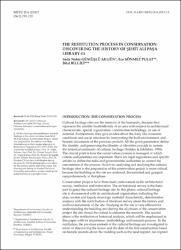| dc.contributor.author | Gumuslu Akgun, Seda Nehir | |
| dc.contributor.author | Sonmez Pulat, Ece | |
| dc.contributor.author | Bilgili, Bilal | |
| dc.date.accessioned | 2021-04-20T08:19:33Z | |
| dc.date.available | 2021-04-20T08:19:33Z | |
| dc.date.issued | 01.01.2019 | en_US |
| dc.identifier.issn | 0258-5316 | |
| dc.identifier.uri | https://doi.org/10.4305/METU.JFA.2019.2.5 | |
| dc.identifier.uri | https://hdl.handle.net/20.500.12573/657 | |
| dc.description.abstract | Conservation of cultural heritage sites is a multi-phased process including the architectural survey, restitution and restoration. Survey phase begins with the preliminary research and in situ analysis, which are crucial for comprehending the specifications, potentials and architectural characteristic of the site. After architectural survey, restitution is carried out to understand the situation in the first period of the site and how it has undergone a change in the historical process. During the restitution studies, alternatives are prepared for various periods by using the traces on the building and archival documents. At the last stage of the conservation process, which is restoration, the interventions for deterioration, repair proposals and spatial organization are determined according to the new/current use.
This study focuses on restitution process of Sehit Ali Pasa Library, which is currently located in the garden of Vefa High School in Kalenderhane Neighbourhood, and consists of four main parts. The first part focuses on general information of the conservation process. In the second part, the historical background, location, spatial organization, construction technique and materials of the building are examined. The restitution or historical analysis process is the main theme of the third part, and all the findings and considerations are evaluated and interpreted in the final part.
In this study, all characteristic features and the layers of the cultural heritage are discussed and documented to indicate the importance of architectural survey and restitution interpretation of the conservation process through the Sehit Ali Pasa Library as a multi-layered example. Unfortunately, the findings in the archives or the libraries are limited to propose certain restitution alternatives or precise historical description for this 18th century library, but it is crucial to underline the importance of detailed research process and methodology, architectural survey to prepare a scientific, reasonable, and consistent historical analyses of cultural heritage such as Sehit Ali Pasa Library as a multi-layered and complex building. | en_US |
| dc.language.iso | eng | en_US |
| dc.publisher | MIDDLE EAST TECHNICAL UNIV, MIDDLE EAST TECHNICAL UNIV, FAC ARCHITECTURE, INONU BULVARI, ANKARA, 06531, TURKEY | en_US |
| dc.relation.isversionof | 10.4305/METU.JFA.2019.2.5 | en_US |
| dc.rights | info:eu-repo/semantics/openAccess | en_US |
| dc.subject | restitution | en_US |
| dc.subject | construction technique | en_US |
| dc.subject | Ottoman Libraries | en_US |
| dc.subject | Sehit Ali Pasa Library | en_US |
| dc.subject | 18th century Ottoman Architectur | en_US |
| dc.title | THE RESTITUTION PROCESS IN CONSERVATION: DISCOVERING THE HISTORY OF SEHIT ALI PASA LIBRARY | en_US |
| dc.type | article | en_US |
| dc.contributor.department | AGÜ, Mimarlık Fakültesi, Mimarlık Bölümü | en_US |
| dc.contributor.authorID | 0000-0002-2727-3370 | en_US |
| dc.identifier.volume | Volume: 36 | en_US |
| dc.identifier.issue | 2 | en_US |
| dc.identifier.startpage | 195 | en_US |
| dc.identifier.endpage | 219 | en_US |
| dc.relation.journal | METU JOURNAL OF THE FACULTY OF ARCHITECTURE | en_US |
| dc.relation.publicationcategory | Makale - Uluslararası - Editör Denetimli Dergi | en_US |


















